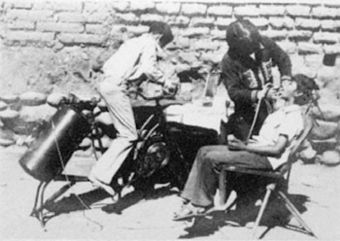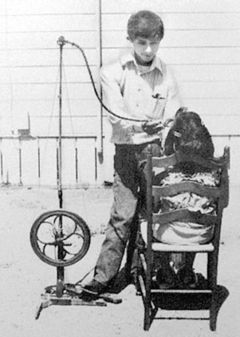Hesperian Health Guides
Placing a Filling
- It stops food, air, and water from touching the cavity. This will prevent much discomfort and pain.
- It stops the decay from going deeper. This can prevent a tooth abscess.
- It can help save the tooth, so the person can use it for many more years.
This chapter shows how to place cement fillings first and then explains how to place permanent fillings using Atraumatic Restorative Treatment. It does not explain how to use a dental drill. Have an experienced dentist train you to use a dental drill if you need to learn how.
Contents
Temporary (Cement) Fillings
If you do not have SDF, you can place a temporary cement filling while someone is waiting for a permanent filling. This can provide relief until the permanent filling can be placed.
In some places, government medical stores can provide most of the instruments as well as cement filling material. If this is not possible, a dentist may be able to help you to order what you need.
Instruments
Many dental instruments look similar, but the small end of each instrument is shaped to do a special task. Try to get as many of these as you can and keep them in a kit.
 | |||
| mirror | probe (explorer) |
tweezers (cotton pliers) |
spoon (spoon excavator) |
| (metal or plastic spatula) for cement or Atraumatic Restorative Treatment |
 OR
(wooden spatula) for cement only" |
||
| filling tool (filling instrument) |
mixing tool |
Some instruments have more than one name. The second one, in parentheses ( ), is the proper name. Use the proper name when you order.
Cement filling material
Many companies make temporary filling material. The names on the packages are different. This makes it hard to know which one to order.
However, the basic material of each product is the same — zinc oxide and oil of cloves (eugenol). To save money, order these two main ingredients in bulk instead of an expensive dental cement filling material.
 |
 |
| Oil of cloves is a liquid. | Zinc oxide is a powder. |
You may be able to buy a special kind of zinc oxide powder called IRM. (Intermediate Restorative Material). Fillings with IRM are stronger and harder, so they last longer. But it is more expensive than zinc oxide and eugenol.
How to place the cement filling
Lay out on a clean cloth:


- Dry the cavity and keep it dry. The cavity and the area around it must be dry so you can see what you are doing. Just as important, cement lasts longer inside a dry cavity. Place cotton between the cheek and gums to keep the area dry. Put some cotton under the tongue when you work on a lower tooth.

Use whatever kind of cotton you have: gauze, wool, or even rolls.
Change the cotton whenever it becomes wet.
Keep the cavity dry while you work. Wipe the inside of it every now and then with a bit of cotton.
Leave a piece of cotton inside the cavity while you mix the cement.
- Lift out the decay. You do not need to remove all of the decay on the bottom of the cavity. If you try to clean out all of the decay, you might touch the nerve.

However, you must remove all of the decay from the edges of the cavity. Otherwise, germs and food can go between the cement and the cavity and keep the decay growing inside. For Atraumatic Restorative Treatment, it is especially important to remove all the decay from the edges so the filling will stick well.
Use the spoon tool to scrape clean the walls and the edge of the cavity. If you find that some part of the tooth at the edge of the cavity is thin and weak, break it deliberately. That makes for stronger sides to hold onto the cement. You can use the end of your filling tool to break the edge but it is much easier with a dental hatchet, which is less likely to bend.
 CAVITYNERVE
CAVITYNERVEUse the spoon tool to lift out soft decay from inside the cavity. Be careful not to go too deep and touch the nerve at the very bottom of the cavity. This takes practice. If the tooth hurts when you do this, stop and inject some local anesthetic.
Use cotton gauze to collect the bits of decay so that the person does not swallow them. Use your mirror and look closely around the edges of the cavity for any decay that you may have missed. Put some cotton inside the cavity and leave it there to keep the area clean and dry while you mix the filling.
These first two steps are also used in placing a filling using Atraumatic Restorative Treatment.
- Mix the cement on a piece of smooth glass. Place separately onto the glass a pile of zinc oxide powder and a few drops of eugenol liquid. Pull a small amount of the powder to the liquid with the mixing tool and mix them together. Add more powder in this way, until the cement mixture becomes thick.


Suggestion: Practice mixing the cement ahead of time to learn how. This will also show you how much time it takes to harden.

Cement is much easier to use when it is thick but not too sticky. Roll a bit between your gloved fingers. If the cement sticks, it is not yet ready. Add more powder and then test again.
Now take the cotton out of the cavity. Make sure the cavity is dry. If the cotton around the tooth is wet, change it.
- Press some cement into the cavity. If a cavity goes down between two teeth, you need to first take care that the cement does not squeeze and hurt the gum.

 space left
space left
for the gumbefore after

Before you apply the cement, place something thin between the teeth. You can use the soft stem from a palm leaf, a toothpick, or a tooth from a comb. Be sure it has a rounded end to prevent damage to the gums.
To apply the cement, put a small ball of cement on the end of your filling tool. Carry it to the cavity. Spread it over the floor of the cavity and into the corners.


Then add another ball of cement, pressing it against the other cement and against the sides of the cavity.
If a cavity goes down between two teeth, one other step is necessary. You need to take care that the cement does not squeeze and hurt the gum.
REMEMBER: Decay stops growing only when the cement covers it completely and tightly.

- Remove the extra cement before it gets too hard. Press the flat side of the filling tool against the cement and smooth it towards the edge of the cavity.
As you smooth the cement, shape it to look like the top of a normal tooth. This way, the tooth above or below it can fit against the filling without breaking it.
If you have placed something between the teeth, remove it and smooth the cement.
Gums are easier to clean, and stay healthier, when the cement beside them is smooth.
Cement that sticks out and is not smooth can hurt the gums. It can also later break off. When that happens, spit and germs are able to go inside and start the decay growing again.
It is also important to look closely around the tooth for loose pieces of cement and to remove them before they make the gums sore.

Use the end of your probe. Gently reach into the gum pocket and lift out any pieces of cement caught there.
Wipe off your probe with cotton gauze each time.
Now remove all the cotton and ask the person to gently close the teeth. The teeth should come together normally and not hit first against the cement filling. Too much pressure against the cement filling will crack and break it. If you do not have carbon paper, darken some paper with a pencil.
If you do not have carbon paper, darken some paper with a pencil.Always check to see if part of the filling is high:
- lf the cement is still wet, you can see the smooth place where the opposite tooth bit into it. Scrape the cement away from this place.
- If the cement is dry, have the person bite on a piece of carbon paper. If there is too much cement, the carbon paper will darken the extra cement but not the surfaces of the nearby teeth. Scrape away the extra cement.
The person must not leave your clinic until
the filled tooth fits properly against the other teeth
After you place the filling
Explain to the person how to take care of the filling so it will not break:
- Do not eat or drink anything for 1 hour — let the filling get hard and strong.
- Try not to use that tooth for biting or chewing after getting a cement filling. Until there is a permanent filling, the cement and sides of the cavity are weak. They cannot take much pressure.
If the tooth hurts more after you place the filling, and you have carefully fixed the bite, there is probably an abscess. If you cannot take out the tooth immediately because of swelling, take out the filling to relieve the pressure, and take out the tooth after you treat the swelling.Clean your instruments after you finish
First scrape the dried cement from the tools. Then clean and disinfect them.

REMEMBER: A cement filling is only a temporary measure. A good one can last up to 6 months. During this time, the person must see a dental worker who has the equipment to put in a permanent filling using Atraumatic Restorative Treatment or a dental drill. For this, the person may have to travel to a dental clinic or wait for a dental worker to visit your area.. For this, the person may have to travel to a dental clinic, or wait for a dental worker to visit your area.
Permanent Fillings (Atraumatic Restorative Treatment)
Atraumatic Restorative Treatment is a way to place a permanent filling without using an expensive dental drill. This method was invented in Tanzania, East Africa, and it is now being used by dental workers in many parts of the world.
Placing a permanent filling using this process is similar to placing a temporary cement filling, but instead of cement you use a sticky material called glass ionomer. Once glass ionomer is in the cavity, it releases fluoride and helps prevent new cavities from forming.
The Instruments and Filling Material you need for ART
The dental instruments you need for Atraumatic Restorative Treatment are the same as the ones for cement fillings. You will also need petroleum jelly (such as Vaseline) and a material called glass ionomer. Glass ionomer comes in “low viscosity,” “medium viscosity,” and “high viscosity” forms (“viscosity” ” describes how thick a liquid is). High viscosity glass ionomer works best for ART because it is the strongest and lasts for a long time.

Glass ionomer is expensive, but sometimes local governments will provide it at lower cost. A package of glass ionomer usually comes as a bottle of liquid and a bottle of powder that you mix together to use.
It is important to store glass ionomer in a cool place.
Follow steps 1 and 2 for cement fillings. Then return here for steps 3 to 6.
To place a filling using Atraumatic Restorative Treatment after treating a cavity with SDF, follow only steps 3 to 6 here.
3. Clean the cavity. After you have removed the decay, clean the cavity so that the glass ionomer will stick well. The best way to do this is with the liquid from the glass ionomer. 
Note: Be sure that the glass ionomer liquid you are using has acid in it and is not just water. If your glass ionomer liquid is just water, clean the cavity with polyacrylic acid or cavity conditioner instead.
Put one drop of glass ionomer liquid on the glass slab. Using the tweezers, pick up a piece of cotton, dampen it in water, then dip it into the glass ionomer liquid. Use the cotton to clean the cavity.
Use another piece of cotton dipped only in water to wash the cavity out. Use a new piece of cotton to wipe out the cavity and dry it.
Put a piece of cotton inside the cavity while you mix the glass ionomer. This will keep the cavity dry.
If a cavity goes down between two teeth, one other step is necessary. You need to take care that the glass ionomer does not stick to the other tooth or squeeze and hurt the gum.
Before you mix the glass ionomer, place something thin between the teeth such as the soft stem from a palm leaf, a toothpick, or a tooth from a comb. A small strip of tin foil or a strip of plastic cut from a plastic bottle will also work. Be sure it has a rounded edge to prevent damage to the gums.
 space left
space left
for the gumbefore after
4. Mix the glass ionomer on a piece of smooth glass just before using it. The package of glass ionomer should have a bottle of liquid, a bottle of powder, a measuring scoop, and instructions for how much to use of each. Place a level scoop of the powder onto the glass, then close the powder bottle right away. Put a drop of liquid separately on the glass. It is important for this liquid to have no air buPut a drop of liquid separately on the glass. Make sure the drop has no air bubbles in it. If it does, keep holding the bottle upside down and put a second drop somewhere else on the glass to use for mixing.
Spread the liquid around a little, pull half of the powder to the liquid with the mixing tool, and mix them together quickly and carefully. Add more powder until you have used the full amount instructed. Be sure to mix in all the powder and do not add extra liquid. This makes the filling strong. The mixture should become thick and smooth like chewing gum.
Now, take the cotton out from inside the cavity. Check to be sure the cavity is dry. If the cotton around the tooth is wet, change it.You can use a drop with air bubbles to clean the cavity for step 3. 

5. Fill the cavity with the glass ionomer right away. Use your filling tool to carry a small amount of the glass ionomer mixture to the cavity. Carefully press the mixture against the sides of the cavity. Then add more glass ionomer to fill the center of the cavity. Work quickly and carefully.


 Remove your finger carefully from the side so you do not lift out the filling.
Remove your finger carefully from the side so you do not lift out the filling.Keep adding glass ionomer until the cavity is over-filled. Put extra glass ionomer in any other pits on the surface of the tooth near the cavity. Rub petroleum jelly on your finger and press down firmly onto the filling for a few seconds, rolling your finger from side to side. This will smooth the top of the filling. 6. Remove extra glass ionomer from the tooth before it gets too hard. Use the spoon tool or the filling tool to quickly and carefully remove any loose pieces of glass ionomer.
Let the glass ionomer harden for less than 1 minute, then ask the person to gently close the teeth. The teeth should come together normally and not hit first against the filling.
 If you do not have carbon paper, darken some paper with a pencil.
If you do not have carbon paper, darken some paper with a pencil.
Check to see if part of the filling is too high by having the person bite on a piece of carbon paper. If there is too much filling, the carbon paper will darken the extra filling but not the surfaces of the nearby teeth. Scrape away the extra filling from that place using the filling tool and check again.The person must not leave your clinic until the filled tooth fits properly against the other teeth.
Permanent Fillings Using a Dental Drill
This chapter has shown how to place a temporary filling with cement and a permanent filling with Atraumatic Restorative Treatment. This book does not give full instructions for placing permanent fillings with a dental drill, but if you have been trained to use a dental drill, see information and ideas about getting equipment and resources.
Some simple dental drills
A dental drill can remove all decay from a cavity and change the shape of the hole in a tooth so it can firmly hold the permanent filling material. The most expensive drills use electricity, but some drills are powered by people instead of electricity.

Village dental workers in the mountains of western Mexico use bicycle power to make compressed air, which runs a high-speed drill.
Local young people or family members volunteer to pump the air while they wait to have their own teeth fixed.
In India and Guatemala, health workers use a foot treadle to power a drill, the same way one can operate a sewing machine. This kind of drill is slower than a compressed-air drill, and the grinding produces a lot of heat, so one must take care not to let the tooth get so hot that it kills the nerves. Still, this is one of the simplest and cheapest ways to place a permanent filling. How a dental drill works

Even if you have the equipment, it is essential that you learn how to make permanent fillings from a person who has
experience using a dental drill.
The tip of the drill (drill bit) is sharp. Some drills spray water on the tooth to keep it cool. Cooling is especially important with a slower treadle-powered drill. An assistant can spray water on the tooth if the drill does not have a sprayer.
As the drill bit moves slowly back and forth, it opens the cavity further. This makes it easier to see all of the decay. The decay is later removed with a spoon tool..

The drill bit also changes the shape of the cavity. The hole in the tooth is shaped so that it will keep the permanent filling material in place.
The filling material, which is made of metal or plastic, must be very strong. It must not break apart when the person chews food or when saliva washes over it.
Do Not Use Mercury Amalgam To Fill Teeth!
For many years, mercury—a shiny, silver-white metal—was used in health care to fill thermometers, blood pressure measuring devices, and as part of metal amalgam to fill teeth. But now the use of mercury has been banned in many countries because it is so toxic (poisonous) to people. Mercury can harm the brain, spinal cord, kidney, and liver, causing tremors (shakiness), sleeplessness, memory loss, headache, nervousness, stomach pain, vomiting, and diarrhea. It is especially harmful to a pregnant person and the developing baby.
Carefully read the descriptions of the filling material you use to make sure it does not contain mercury. Other materials, such as composite, glass ionomer, ceramics, etc. may be just as available, affordable, and effective. And they are much safer for you, your patients, and the environment.
This page was updated:14 Aug 2025 - Mix the cement on a piece of smooth glass. Place separately onto the glass a pile of zinc oxide powder and a few drops of eugenol liquid. Pull a small amount of the powder to the liquid with the mixing tool and mix them together. Add more powder in this way, until the cement mixture becomes thick.


